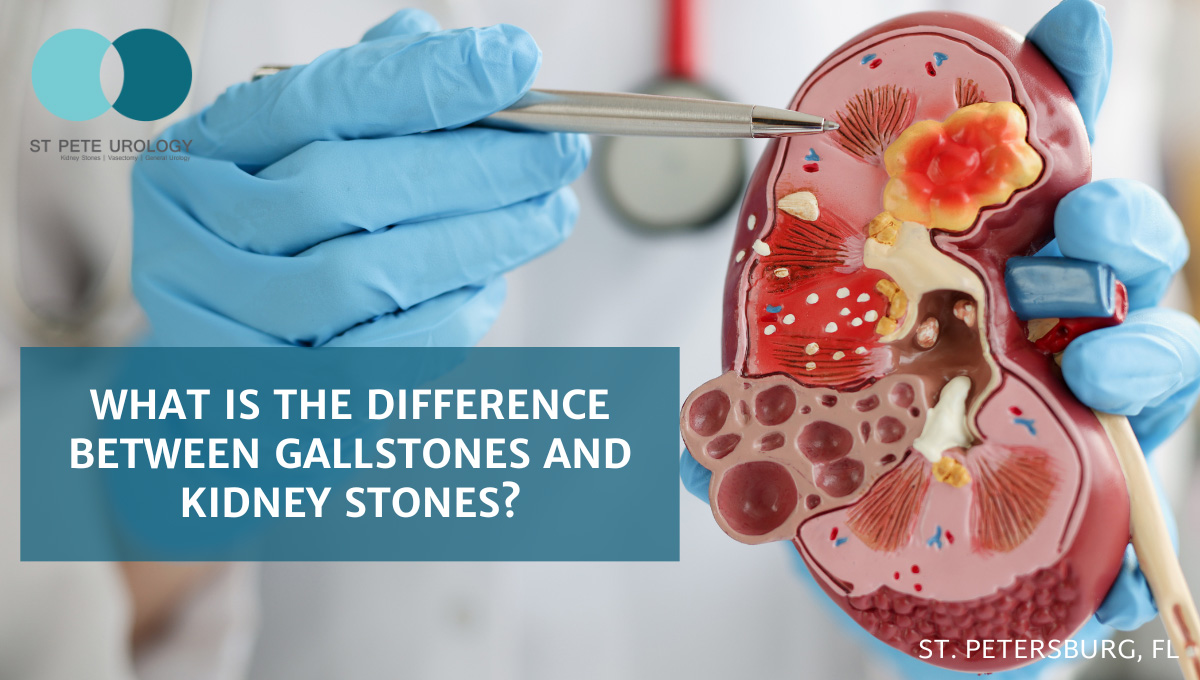3 Key Takeaways:
- Gallstones and Kidney Stones are two different conditions that occur in different organs and have different causes, symptoms, and treatments.
- Gallstones share some risk factors with kidney stones including age, obesity, a sedentary lifestyle, a high-fat, high-cholesterol diet, and certain medical conditions.
- If not addressed, both gallstones and kidney stones can lead to severe complications, including gallbladder inflammation and kidney damage.


Gallstones: The Unwanted Pebbles in Your Gallbladder
Gallstones are hard deposits that form in the gallbladder, typically resulting from an accumulation of cholesterol or bilirubin, a byproduct of red blood cell breakdown. Certain factors increase the risk of developing gallstones, such as age, obesity, a sedentary lifestyle, or a diet high in fat and cholesterol. Women, particularly those who are pregnant or on hormone therapy, are more prone to gallstones.
Symptoms of gallstones usually manifest as sudden, intensifying pain in the upper-right abdomen or the center of the abdomen. Other symptoms include nausea, vomiting, back pain between the shoulder blades, or jaundice. Diagnosing gallstones often involves an ultrasound or an endoscopic ultrasound, but other tests like blood tests or CT scans can also be utilized.
Kidney Stones: The Silent Invaders of Your Kidneys
Kidney stones are hard mineral and salt deposits that form inside the kidneys. Factors that increase the risk of kidney stones include urinary tract infections, dehydration, a diet high in protein, sodium, and sugar, obesity, and specific medical conditions like renal tubular acidosis, cystinuria, or hyperparathyroidism.
Unlike gallstones, kidney stones may not cause symptoms until they begin to move, leading to intense pain on one side of the back or abdomen. Other symptoms include bloody, cloudy, or odorous urine, an urge to urinate frequently, and sometimes, fever and chills. Kidney stones are usually diagnosed through blood and urine tests, imaging techniques, or by analyzing stones that have been passed.
Decoding the Differences: Gallstones vs. Kidney Stones
The primary difference between gallstones and kidney stones is their location. Gallstones form in the gallbladder, located below the liver, while kidney stones develop in the kidneys, positioned on either side of the spine. The composition of these stones also differs; gallstones are made of cholesterol or bilirubin and are usually yellow, whereas kidney stones consist of substances like calcium, oxalate, uric acid, or cystine, and vary in color from yellow to brown.
The nature of pain caused by these stones is also distinct. Gallstone pain typically affects the upper-right abdomen, while kidney stone pain is more localized to one side of the back or abdomen. Treatment approaches differ as well; gallstones may require surgery if symptoms are persistent, whereas kidney stones often pass naturally, although larger stones might necessitate surgical intervention.
Kidney Stones and The Share Reality with Gallstones
Despite their differences, kidney stones share some commonalities with gallstones. They often form due to a combination of genetic and dietary factors, with obesity and certain dietary habits being common risk factors. Both conditions can lead to severe complications if left unaddressed — gallstones can cause inflammation of the gallbladder, and kidney stones might result in kidney damage.
Conclusion
While gallstones share some similarities with kidney stones, their differences in origin, appearance, symptoms, and treatment are significant. Understanding these distinctions is key to identifying the right medical care promptly. If you’re in St. Petersburg, FL, and experiencing symptoms of these conditions, consider consulting the professionals at St Pete Urology. Their experienced team can provide accurate diagnoses and effective treatments for kidney stones, guiding you toward better health. Recognizing the nuances of your body is a crucial step in avoiding unnecessary pain and complications. Stay informed and stay healthy.
References:
- “Gallstones – Symptoms and Causes – Penn Medicine.” https://www.pennmedicine.org/for-patients-and-visitors/patient-information/conditions-treated-a-to-z/gallstones.
- “Hyperparathyroidism – Symptoms & causes – Mayo Clinic.” https://www.mayoclinic.org/diseases-conditions/hyperparathyroidism/symptoms-causes/syc-20356194.
- “Gallstones vs. Kidney Stones: Differences, Symptoms, and Treatment.” 5 Dec. 2022, https://www.healthline.com/health/gallstones-vs-kidney-stones.




